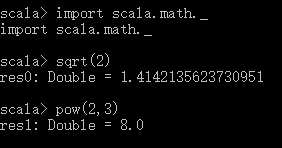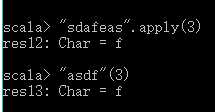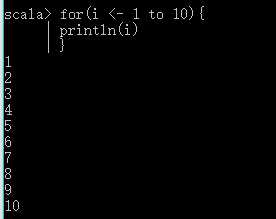【未完成】Scala 基礎
0. 說明
1. 基本概念
1.0 Scala是什麽
Scala 是一門多範式的編程語言,設計初衷是要集成面向對象編程和函數式編程的各種特性。
1.1 變量 & 常量
在 Scala 中,使用關鍵詞 "var" 聲明變量,使用關鍵詞 "val" 聲明常量。
# 變量,可以對值進行更改 var a = 10 # 常量,不能更改 val a = 10
1.2 函數 & 類的區別
- 函數,不需要使用類,直接調用
- 方法需要通過類調用
1.3 產生1 ~ 10的序列
1 to 10 相當於 1.to(10)

1.4 字符串交集
"hello".intersect("world")

1.5 BigInt 類型
var b = BigInt(999999)
1.6 Scala 自增
Scala 不像 Java 那樣使用 a++ a-- 作為自增自減
而是使用以下
a += 1
a -= 1
1.7 使用函數
導入 math 下的所有成員
import scala.math._
sqrt(2) //開方
pow(2,3) //冪函數

1.8 apply 方法
"hello".apply(0)
"hello"(0)

1.9 表達式
val x = 2
val b = if(x > 0 ) 1 else -1 // Scala中不包含三元運算

// b:AnyVal = ()
val b = if(x < 0) -1
val x:Unit = () //相當於null

1.10 語句整體
val b = if(x > 0 ){1
}else -1
1.11 粘貼
:paste
ctrl + d //退出粘貼模式
1.12 語句終止
同一行多條語句之間用 " ; " 分隔
val b = {println("a") ;println("bbb");100}

1.13 輸出 & 輸入
// 輸出
println("xxx")
printf("aaa %s bb %s" , "abc" , "def")

// 輸入,讀取控制臺輸入
var name = readLine("請輸入名字:")
println(name)

2. 循環
2.1 while 循環
var n = 0 ; while(n < 10){ println(n) n +=1 }

2.2 for 循環
for(i <- 1 to 10){ println(i) }

2.3 使用 while 和 for 輸出 99 表格
var r = 1 while(r < 15){ var c = 1 while(c <= r){ printf("%dx%d=%d\t" , c , r , (c * r)) if(c == r) println() c+=1 } r +=1 }
//for循環
for(i <- 1 to 9){
for(j <- 1 to i){
printf("%dx%d=%d\t" , j , i , (i * j))
if(i == j)println()
}
}
//until, 1 ~ 9
val a = 1 until 10
//break和continue
import scala.util.control.Breaks._
for(i < 1 to 10){
println(i)
break ;
}
//高級for循環 , 迪爾卡積
for(i <- 1 to 9 ; j <- 1 to i){
printf("%dx%d=%d\t" , j , i i * j)
if(i == i)println()
}
//守衛條件for循環
for(i <- 1 to 9 ; j <- 1 to i if( i == 2 * j)){
printf("i=%d,j=%d\r\n" , i , j)
}
//yield ,產生新集合
for(i <- 1 to 5) yield i * 2
//定義函數
def add(a:Int,b:Int):Int = a + b
//定義函數,實現n的階乘
5! = 5 x 4x 3x 2x 1 ;
def fac(n:Int) = {
var r = 1
for(i <- 1 to n){
r *= i
}
r
}
//遞歸函數必須顯式定義返回類型
def fac(n:Int):Int = if(n == 1) 1 else n * fac(n - 1)
//定義函數,參數數帶有默認值
def decorate(prefix:String="{{{" , str:String , suffix:String="}}}") = {
prefix + str + suffix
}
//帶名參數
decorate(str = "hello" )
//變長參數
def add(x:Int*) = {var sum = 0 ;for(i <- x)sum += i ;sum}
add(1,2,3,4,5)
add(1 to 5:_*) //把range對象打散成數字序列,1,2,3,4,5
//過程,沒有=的函數,
def out(){println("hello world")}
//lazy,延遲計算
val x = 1/ 0
lazy val x = 1 / 0
x
//定義數組 [泛型]
val arr = new Array[Int](10)
arr(0) = 1
arr(1) = 2
arr(2) = 3
for(i <- 0 until arr.length ) arr(i) = i + 1
val arr = Array[String]("hello","world")
val arr = Array("hello","world")
val arr = Array.apply("hello","world")
val arr = Array.apply[String]("hello","world")
val arr = Array[Int](100) //一個100的值
val arr = new Array[Int](100) //100個0
//命名法則:
//++ 加多個元素
//+ 加一個元素
//+= =表示修改自身的內容
//數組緩沖區(集合)
//=修改自身的內容,否則生成新集合
import scala.collection.mutable.ArrayBuffer
val buf = ArrayBuffer[Int](1,2,3)
val x = buf.++(4 to 10)
buf.++=(4 to 10)
buf.+=(1,2,3,4) //追加多個元素
buf += 12
buf.trimEnd(3) //移除末尾3個元素
buf.insert(0,-2,-1,0) //在指定的索引位置,插入數字序列
buf.toArray()
//倒序遍歷
for(i <- (0 until buf.length).reverse) println(buf(i))
//常用操作
buf.sum
//mkStrig,連接元素成串
buf.mkString(",")
buf.mkString("{{{" ,"," , "}}}")
//多維數組
val arr = new Array[Array[Int]](2)
val arr = Array.ofDim[Int](3,4)
//java集合和scala buffer之間的互操作
val list:java.util.List[String] = new java.util.ArrayList[String]()
list.add("hello")
list.add("world")
//定義函數,使用java的list類型
def mylist(list:java.util.List[String]) = println(list.size())
val buf = ArrayBuffer[String]("how" , "are" , "you")
mylist(buf) //類型不匹配
import scala.collection.JavaConversions.bufferAsJavaList
mylist(buf) //ok
//定義scala參數緩沖區的函數
def mybuf(buf:scala.collection.mutable.Buffer[String]) = println(buf.size())
import scala.collection.JavaConversions.asScalaBuffer //隱式轉換
mybuf(list);
//映射map,不可變
val map = Map(1->"tom" , 2->"tomas" , 3->"tomasLee")
map(1)
map(2)
map(3)
//可變集合,導類指定別名
import scala.collection.mutable.{Map=>MMap}
val map = MMap(1->"tomas" , 2->"tomasLee")
map(1)
//對偶是一個kv對,等價於java Map中Entry.
val c = 100->"tomas"
val c = (100 , "tomas")
//map
val map = MMap(("001","tom"),("002","tomas"),("003","tomasLee"))
//叠代map
for(k <- map.keys) println(k)
for(v <- map.values) println(v)
for((k,v) <- map) println(k + " : " + v)
for(c <- map) println(c._1 + " : " + c._2)
//
map.contains("001")
val v = map.getOrElse("001" , "nobody")
map.+=(( "006", "tom6"))
map.+=("006"->"tom6")
map.-=("006")
val m1 = scala.collection.immutable.SortedMap(1->"tom1" , 3->"tom3",2->"tom2")
for(c <- m1) println(c)
//元組tuple
val t = ( 1,,"tom",12)
val t:Tuple3[Int,String,Int] = new Tuple3[Int,String,Int](1 , "tom",12) ;
t._1
t._1 = 100 //錯的,元組的組員是不能重新賦值
//拉鏈 zip
val ids = (1,2,3)
val names= ("tom1" , "tom2", "tom3")
ids.zip(names)
ids.zipAll(names,-1, "nobody") //全拉鏈,-1左邊填充元素,"nobody"右側填充元素

【未完成】Scala 基礎
